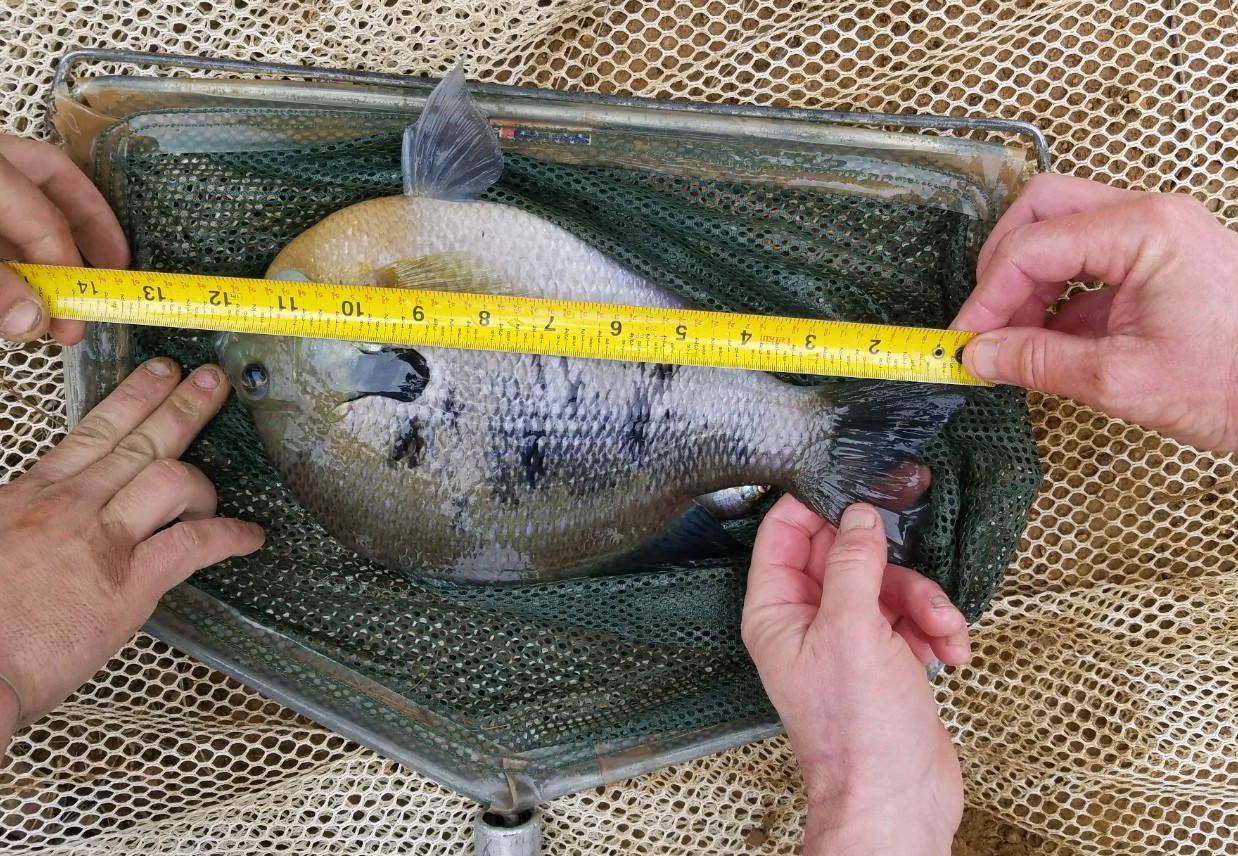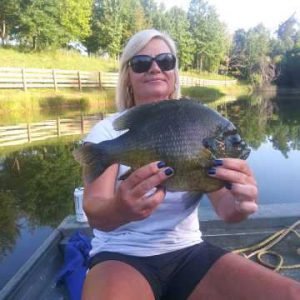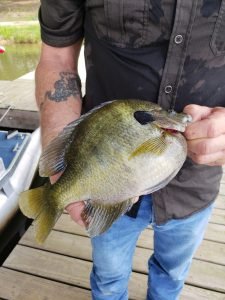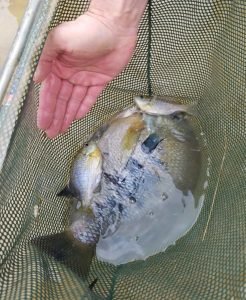Mystery Solved, Or: Three in Five Months
Up until a few days ago, whenever a new customer asked me which got bigger, coppernose or hand-painted bluegill, I would give them a complicated answer. We’re going to do a study at some point, I would say (we’re hoping to get this done within the next year) and will have hard data; as of right now, I can only go off what I have observed. I would then tell them that the hand-painteds in our production ponds grew at a very good rate, comparable to or even exceeding coppernose, but that the biggest hand-painted we had weighed was only 1.8 pounds (this changed three weeks ago when we weighed one that went 1.9 lbs), whereas I had seen photos of coppernose that weighed three pounds or more, and had seen some that big in ponds I have managed. I would tell them that I believed that hand-painteds could get that big, but I didn’t know for sure; I would then tell them that coppernose were a sure thing, and could be grown to three pounds in the right conditions.Regarding uncertainty as to whether hand-painteds can be grown to three pounds: We didn’t get a weight on this fish. We had an inexpensive digital scale with us, a postal scale to be precise, when we found this giant in our seine; though said scale seemed to work fine when it registered 1.9 pounds for the big hand-paint we weighed three weeks ago, it clearly was badly off last Saturday. We weighed four other large male hand-paints prior to coming across the giant, and all of them were several ounces off from what they should have weighed, so we didn’t even put this fish on the scale. We have had expensive bench and washdown scales in the past for weighing fish, but they get damaged in the line of duty, and I made the mistake of thinking a cheapo scale would suffice - not planning, obviously, on encountering a beast like above, and not considering how I might feel (not great) when said beast was encountered without a working scale.We also didn’t get a precise length measurement, and this I don’t much regret: my top priority was getting that fish back in the pond as quickly as possible, without removing any of his slime coat or in any way harming him, even if it meant not getting that perfect image for posterity. We do things differently than other companies in this business, and that translates to every detail, including the not-insignificant detail of whether or not this amazing fish’s genes continue to get passed on to lots of other hand-paints so that in turn our overall stock quality can be further improved, further separating us from our competition and giving our customers ponds that are that much more exceptional than ponds managed by other companies. I could have held him up for that perfect photo, but that would have risked the fish flopping at just the wrong moment and landing on the ground, which would have drastically reduced his chances of survival. We could have taken the extra time to lift him out of the net so we could get the measuring tape under him and thereby get a precise length, but here again, handling him would have opened him up to disease, and would have given him a chance to flop out of my hands and onto the ground, which would have wreaked havoc with his slime coat and, depending on the height of the fall, also potentially caused internal injuries that would have killed the fish.So we held the measuring tape above him, as close as we could, and tried to get his tail straightened out to get his full length (he was big enough that he was pushing on either end of the bag of the dip net). My lead employee announced that the fish was a full thirteen inches long; but of course the best photo we got is poor at best, and makes the fish appear to be around 12.5” because of the camera placement and the fact the tape is still inches above the fish and the fish’s tail is still not straightened. Most relevantly, the two lobes of the tail were not squeezed together, as is supposed to be done when measuring length for a fish; that alone would have added a half inch, possibly more with this fish (note that just the tail of this fish is three inches long).Now for the gloating part of this post. Every now and then, a new customer points out that a lot of my blog posts are more than a little critical of my competitors. I am aware of that old expression, “If you can’t say anything nice, don’t say anything at all.” However, I also know that the apostle Paul, rather than politely looking the other way when false teachers led baby Christians astray, called them to account, bluntly and directly; on at least one occasion he expressly damned some of them to hell. If it were just a matter of good-natured competition among honest men, I would never have written a detracting word about any of my competitors; but as I have noted previously, some of said competitors regularly violate federal anti-trust laws and employ shady business practices in attempts to drive smaller companies such as myself out of business. They can’t compete with me when it comes to results, so they cheat and steal and sell at margins that would bankrupt Wal-Mart. And they deserve to be called to account for it, because they’re cheating you, the lake or pond owner, out of your best fishing, if you hire them rather than me.More than one of my competitors claims to be able to manage ponds for trophy bluegill. One of those competitors goes so far as to market himself as the expert on trophy bluegill management. If you’re currently looking for a company to manage your lake or pond for trophy bluegill, and you have talked to one of those other companies, or if you’re already paying one of those companies to manage your water for trophy bluegill, ask them how many bluegill in the 2.5- to 3-pound class they have ever produced, out of the hundreds or thousands of waters they have managed for all the years they have been in business. That competitor who claims to be the big-bluegill expert has posted a total of two photos of bluegill that big, from any water he has managed anywhere, in over thirty years of management; both came from one lake that is well over a hundred acres in size. “Influence of lake surface area and total phosphorus on annual Bluegill growth in small impoundments of central Georgia,” (Sundmark and Jennings 2016) found that the single biggest determinant of bluegill size in a water body was the size of the impoundment, followed by the phosphorus levels in the water.In the last four and a half months, dating from August 2, 2019 until now, three bluegill in this size class from three different ponds managed by our company have been documented; one of them I weighed myself (2 lbs. 14 oz.); the other two were not weighed. One of those fish was a coppernose; one was a hand-painted; one was a northern bluegill. One pond was seven acres in size, and the other two were one-acre ponds. If you can find any other private fisheries consultant in the U.S. that can show you photos of three bluegill this size that he has produced in a five-month span, he can rightly claim to be on a par with us; otherwise, those other guys are just lying to you. And you deserve better.
We didn’t get a weight on this fish. We had an inexpensive digital scale with us, a postal scale to be precise, when we found this giant in our seine; though said scale seemed to work fine when it registered 1.9 pounds for the big hand-paint we weighed three weeks ago, it clearly was badly off last Saturday. We weighed four other large male hand-paints prior to coming across the giant, and all of them were several ounces off from what they should have weighed, so we didn’t even put this fish on the scale. We have had expensive bench and washdown scales in the past for weighing fish, but they get damaged in the line of duty, and I made the mistake of thinking a cheapo scale would suffice - not planning, obviously, on encountering a beast like above, and not considering how I might feel (not great) when said beast was encountered without a working scale.We also didn’t get a precise length measurement, and this I don’t much regret: my top priority was getting that fish back in the pond as quickly as possible, without removing any of his slime coat or in any way harming him, even if it meant not getting that perfect image for posterity. We do things differently than other companies in this business, and that translates to every detail, including the not-insignificant detail of whether or not this amazing fish’s genes continue to get passed on to lots of other hand-paints so that in turn our overall stock quality can be further improved, further separating us from our competition and giving our customers ponds that are that much more exceptional than ponds managed by other companies. I could have held him up for that perfect photo, but that would have risked the fish flopping at just the wrong moment and landing on the ground, which would have drastically reduced his chances of survival. We could have taken the extra time to lift him out of the net so we could get the measuring tape under him and thereby get a precise length, but here again, handling him would have opened him up to disease, and would have given him a chance to flop out of my hands and onto the ground, which would have wreaked havoc with his slime coat and, depending on the height of the fall, also potentially caused internal injuries that would have killed the fish.So we held the measuring tape above him, as close as we could, and tried to get his tail straightened out to get his full length (he was big enough that he was pushing on either end of the bag of the dip net). My lead employee announced that the fish was a full thirteen inches long; but of course the best photo we got is poor at best, and makes the fish appear to be around 12.5” because of the camera placement and the fact the tape is still inches above the fish and the fish’s tail is still not straightened. Most relevantly, the two lobes of the tail were not squeezed together, as is supposed to be done when measuring length for a fish; that alone would have added a half inch, possibly more with this fish (note that just the tail of this fish is three inches long).Now for the gloating part of this post. Every now and then, a new customer points out that a lot of my blog posts are more than a little critical of my competitors. I am aware of that old expression, “If you can’t say anything nice, don’t say anything at all.” However, I also know that the apostle Paul, rather than politely looking the other way when false teachers led baby Christians astray, called them to account, bluntly and directly; on at least one occasion he expressly damned some of them to hell. If it were just a matter of good-natured competition among honest men, I would never have written a detracting word about any of my competitors; but as I have noted previously, some of said competitors regularly violate federal anti-trust laws and employ shady business practices in attempts to drive smaller companies such as myself out of business. They can’t compete with me when it comes to results, so they cheat and steal and sell at margins that would bankrupt Wal-Mart. And they deserve to be called to account for it, because they’re cheating you, the lake or pond owner, out of your best fishing, if you hire them rather than me.More than one of my competitors claims to be able to manage ponds for trophy bluegill. One of those competitors goes so far as to market himself as the expert on trophy bluegill management. If you’re currently looking for a company to manage your lake or pond for trophy bluegill, and you have talked to one of those other companies, or if you’re already paying one of those companies to manage your water for trophy bluegill, ask them how many bluegill in the 2.5- to 3-pound class they have ever produced, out of the hundreds or thousands of waters they have managed for all the years they have been in business. That competitor who claims to be the big-bluegill expert has posted a total of two photos of bluegill that big, from any water he has managed anywhere, in over thirty years of management; both came from one lake that is well over a hundred acres in size. “Influence of lake surface area and total phosphorus on annual Bluegill growth in small impoundments of central Georgia,” (Sundmark and Jennings 2016) found that the single biggest determinant of bluegill size in a water body was the size of the impoundment, followed by the phosphorus levels in the water.In the last four and a half months, dating from August 2, 2019 until now, three bluegill in this size class from three different ponds managed by our company have been documented; one of them I weighed myself (2 lbs. 14 oz.); the other two were not weighed. One of those fish was a coppernose; one was a hand-painted; one was a northern bluegill. One pond was seven acres in size, and the other two were one-acre ponds. If you can find any other private fisheries consultant in the U.S. that can show you photos of three bluegill this size that he has produced in a five-month span, he can rightly claim to be on a par with us; otherwise, those other guys are just lying to you. And you deserve better.


